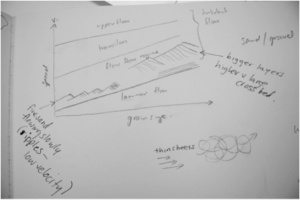Cross-Training in Cross-Bedding Post
Cross Training in Cross Bedding
Post by: Annalea Beattie
How do we understand the relationships between grain size and current velocity in cross-bedded sandstone?
This afternoon we began cross training on features of the local sandstone geology with geologist Dr. Jon Clarke. We began with the nomenclature of physical sediments – the differences between sand and mud and clay and silt.
Jon defined anything above 2mm as gravel. 62 microns (a thousandth of a millimetre) to 2mm as sand, that’s grain size.
Less than 62 microns is silt and less than four microns is clay and both together are classified as mud. The eye stops seeing at 62 microns.
Clastic sediment is rock made up of fragments of older rocks. In terms of our local environment around the Mars Desert Research Station, it’s mostly made up of mudstone, (mudstone that breaks up into little pieces is called shale), and sandstone.
Viscosity is a significant factor is the way materials are transported. In a torrent racing down the mountain, coarse materials like big boulders and rocks are carried along by the high density of water. A lazy stream moves fine sand with little energy but cannot transport boulders or even coarse sand. The finer the grain size the lower the energy needed to move it.
Winds blow sand with ease, forming cross-bedded dunes in asymmetric shapes that typically steep (30-35 degrees). Dune sand grains are generally very well-rounded, compared to those in water-laid sediments. Water-formed cross-bedding are typically formed at angles of 10 to 20 degrees.

We can say that the shape of pebbles might tell us something about the way they have been formed and how far they have travelled. For instance, least travelled pebbles are often angular in shape. The rounder a rock is could mean it has been subject to abrasion in transportation- its edges erode through contact with other rocks and are smooth.
Sands grains, whether they are moved with air or water become sorted according to size and their shape and size changes. So size and grain shape also can indicate velocity and distance. But what if the rock is a very hard rock like a diamond ? It could travel a long way and not shatter or even get rounded.
The point is, to make observations in geology we need to combine a collection of basic principles and evidence in the field that is brought together to make a science narrative. Jon’s diagrams really helped us understand today’s’ session one of
cross-bedding cross-training. Session Two to follow.



